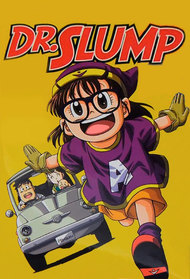Remember that feeling of being completely overwhelmed by a mountain of homework? Now imagine that feeling, but instead of textbooks and exams, you’re facing down complex scientific problems with an eccentric inventor and a mischievous robot by your side. This is the essence of “Doctor Slump,” a beloved anime series that follows the wacky adventures of Arale Norimaki, a powerful android, and her creator, Senbei Norimaki, a brilliant but somewhat absent-minded scientist. And in Season 1, Episode 15, titled “The Big Bang Theory,” we’re treated to a hilarious and thought-provoking exploration of science, with Arale’s boundless energy and Senbei’s quirky inventions taking center stage.

Image: simkl.com
The episode delves into the topic of the Big Bang theory, a cornerstone of modern cosmology. However, it does so with a comedic twist, weaving in Arale’s childlike understanding of the universe and Senbei’s tendency to create wacky gadgets. This clash of perspectives leads to some uproarious moments, but also to insights that are both heartwarming and insightful.
A Whimsical Look at Scientific Theories
The Big Bang Simplified:
In “Doctor Slump,” the Big Bang is presented as an exciting event that resulted in Arale’s creation. Senbei, in his usual eccentric fashion, explains the theory to Arale by comparing it to a giant ball of dough expanding and creating the infinite expanse of the universe. While a bit simplistic, the idea captures the key concept of the Big Bang—that the universe began from a small, dense state and has been expanding ever since.
Arale’s Cosmic Perspective
Arale, with her unfiltered and childlike curiosity, asks questions that surprisingly make sense. She wants to know what caused the Big Bang, why the universe is so big, and what came before it. These questions, though seemingly simple, are fundamental to the study of cosmology. Arale’s inquisitiveness serves as a reminder that even the most complex scientific theories can be understood through simple, straightforward language.

Image: www.betaseries.com
Science Through a Lens of Humor
The episode humorously depicts Senbei’s attempts to explain the Big Bang and other scientific concepts, like black holes, to Arale. His oversimplifications and quirky explanations often lead to misunderstandings, creating funny situations that highlight the potential for humor in even the most serious of scientific endeavors. While the episode may not be a scientifically accurate representation of these concepts, it presents them in a way that is both entertaining and accessible.
Beyond the Laughter
Beneath the humor lies a deeper message about the importance of scientific curiosity. Arale’s unyielding inquisitiveness and Senbei’s willingness to embrace the unknown, even if it means making mistakes, remind us that the pursuit of knowledge should be driven by a sense of wonder and a desire to explore the world around us.
The Magic of Science
“The Big Bang Theory” reinforces the idea that science is not just about formulas and equations, but also about imagination and passion. The episode uses its playful approach to science to inspire viewers, particularly children, to engage with science and explore its vast and fascinating possibilities.
Tips for Engaging Young Minds in Science
Inspired by “Doctor Slump” and its unique approach to scientific concepts, here are a few tips for engaging young audiences with science:
1. Make Learning Fun:
Just like Arale and Senbei, use humor and creative storytelling to make learning appealing. Let kids experiment, ask questions, and discover new things through play. The more engaging the learning experience, the more likely they are to develop a love for science.
2. Connect Science to Everyday Life:
Show kids how science is relevant to their own lives. Explore how things work, from the gadgets in their hands to the natural wonders around them. Connect scientific principles to everyday occurrences, making them relatable and interesting.
3. Embrace Mistakes:
Remember Senbei’s crazy inventions? They don’t always work perfectly, but they demonstrate the importance of experimentation and learning from mistakes. Encourage kids to be curious, try new things, and not be afraid to stumble along the way.
FAQ:
Q: What is the Big Bang theory?
The Big Bang theory is the prevailing cosmological model for the universe. It suggests that the universe began from a state of extremely high density and temperature, and has been expanding ever since.
Q: How does “Doctor Slump” represent the Big Bang theory?
“Doctor Slump” uses a whimsical and simplified approach, describing it as a giant ball of dough expanding and creating the universe. While not scientifically accurate, it captures the core idea in a way that is accessible to a younger audience.
Q: Why is “Doctor Slump” a good anime for teaching kids about science?
“Doctor Slump” is a fantastic example of how to make science fun and engaging for children. It combines humor, relatable characters, and simple explanations to introduce complex scientific concepts in a way that is both entertaining and informative.
Doctor Slump Season 1 Episode 15
Conclusion:
“Doctor Slump” Season 1, Episode 15 shows us that science can be hilarious and exciting. By embracing creativity and humor, we can inspire young minds to explore the universe and discover the wonders of scientific knowledge, Let’s keep the spirit of learning alive with a sense of playfulness, just like Arale and Senbei!
What do you think about “Doctor Slump” and its approach to teaching science? Share your thoughts in the comments below!





